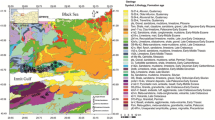Abstract
Predicting the properties of rocks is aided by the use of indirect methods such as electrical resistivity. This article investigates the predictability of the physical and mechanical properties of pyroclastic rocks from electrical resistivity tests. Twenty-four different pyroclastic rocks were collected, and physico-mechanical and electrical resistivity tests were carried out in the laboratory. The experimental data were assessed using regression analysis. Simple regression analysis showed that there were generally strong correlations between the resistivity and rock properties including uniaxial compressive strength, Brazilian tensile strength, density, and porosity. Multiple regression equations were also derived for the prediction of compressive and tensile strength. The statistical test showed that the derived equations were valid. Therefore, it can be concluded that electrical resistivity tests can be effectively used to estimate the physico-mechanical properties of pyroclastic rocks.








Similar content being viewed by others
References
Ara, T., Bjorndalen, N., Talabani, S., & Islam, M. R. (2004). Predicting oil reserve in carbonate reservoirs. EEC Innovation, 2, 20–43.
Archie, G. E. (1942). The electrical resistivity log as an aid in determining some reservoir characteristics. Transactions of the AIME, 146, 54–62.
Bilim, N., Ozkan, I., & Gokay, M. K. (2002). Determination of discontinuities at rock materials by electrical resistance method. In C. Sensogut & I. Ozkan (Eds.), Proceedings of 7th regional rock mechanism symposium (pp. 121–127). Kozan Ofset.
Brace, W. F., Orange, A. S., & Madden, T. R. (1965). The effect of pressure on the electrical resistivity of water-saturated crystalline rocks. Journal of Geophysical Research, 70, 5669–5678.
Chelidze, T. L., Gueguen, Y., & Ruffet, C. (1999). Electrical spectroscopy of porous rocks: A review-II. Experimental results and interpretation. Geophysical Journal International, 137, 16–34.
Collett, L. S., & Katsube, T. J. (1973). Electrical parameters of rocks in developing geophysical techniques. Geophysics, 38, 76–91.
Ince, I. (2018). Determination of index-strength properties of pyroclastic rocks by electrical resistivity method. OHU Journal of Engineering Sciences, 7(2), 772–780. In Turkish.
Jodicke, H. (1990). Zonen hoher elektrischer Krustenleitfahigkeit im Rhenoherzynikum and seinem nordlichen Vorland, Ph.D Thesis, Münster University.
Kahraman, S., & Alber, M. (2006). Predicting the physico-mechanical properties of rocks from electrical impedance spectroscopy measurements. International Journal of Rock Mechanics and Mining Sciences, 43, 543–553.
Kahraman, S., & Yeken, T. (2010). Electrical resistivity measurement to predict the uniaxial compressive and tensile strength of igneous rocks. Bulletin of Materials Science, 33, 731–735.
Kaselov, A., & Shapiro, S. A. (2004). Stress sensitivity of elastic moduli and electrical resistivity in porous rocks. Journal of Geophysics and Engineering, 1, 1–11.
Kate, J. M., & Sthapak, A. K. (1995). Engineering behaviour of certain Himalayan rocks. In J. J. K. Daemen & R. A. Schultz (Eds.), Rock mechanics 35th US symposium rock mechanism (pp. 783–788). Springer.
Ranjbar, S., & Nasab, S. K. (2019). Determination of uniaxial compressive strength of granite rock samples using electrical resistivity measurement: NDT. EAGE-GSM 2nd Asia Pacific Meeting on Near Surface Geoscience & Engineering, April 2019, Kuala Lumpur, Malaysia, pp. 22–26.
Sayin, M.N. (2008). Fairy chimney development in Cappadocian ignimbrites (Central Anatolia, Turkey). Ph.D. Thesis, Middle East Technical University. p. 137.
Schmeling, H. (1986). Numerical models on the influence of par-tial melt on elastic inelastic and electrical properties of rocks. Part II electrical conductivity. Physics of the Earth and Planetary Interiors, 43, 123–135.
Schön, J. H. (1998). Physical properties of rocks: Fundamentals and principles of petrophysics (2nd ed.). Pergamon Press.
Shankland, T. J., & Waff, H. S. (1997). Partial melting and electrical conductivity anomalies in the upper mantle. Journal of Geophysical Research, 82, 5409–5417.
Shogenova, A., Joeleht, A., Kirsimae, K., Sliaupa, S., Rasteniene, V., & Babele, A. (2001). Electric properties of siliciclastic rocks in the Baltic Cambrian basin. In K. Backe & T. Loermans (Eds.), Proceedings of 6th Nordric symposium. Petrophysics (pp. 1–14). Norwegian University of Science and Technology.
Su, O., & Momayez, M. (2017). Indirect estimation of electrical resistivity by abrasion and physico-mechanical properties of rocks. Journal of Applied Geophysics, 143, 23–30.
Vinegar, H. J., & Waxman, M. H. (1984). Induced polarization of shaly sands. Geophysics, 49, 1267–1287.
Vipulanandan, C., & Garas, G. V. (2008). Electrical resistivity, pulse velocity, and compressive properties of carbon fiber-reinforced cement mortar. Journal of Materials in Civil Engineering, 20(2), 93–101.
Acknowledgements
The author thanks Emre Öğretici, who assisted in carrying out the experiments.
Author information
Authors and Affiliations
Corresponding author
Ethics declarations
Conflict of interest
The author states that there is no conflict of interest.
Additional information
Publisher's Note
Springer Nature remains neutral with regard to jurisdictional claims in published maps and institutional affiliations.
Rights and permissions
About this article
Cite this article
Kahraman, S. Estimating the Physico-Mechanical Properties of Pyroclastic Rocks from Electrical Resistivity. Pure Appl. Geophys. 179, 301–309 (2022). https://doi.org/10.1007/s00024-021-02898-6
Received:
Revised:
Accepted:
Published:
Issue Date:
DOI: https://doi.org/10.1007/s00024-021-02898-6




